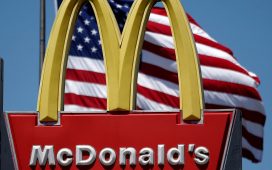Australians are buying less fruit and vegetables and consuming less milk, as relentless increases in grocery prices upend eating habits, raising concerns over the nation’s health.
Overall, shoppers are buying less of just about everything, with consumption falling from 15.1m tonnes to 14.8m tonnes in 2022-23, according to Australian Bureau of Statistics data released on Friday.
Many consumers, however, are forgoing fresh produce to load their diets with confectionery and other snacks, which have spiked in popularity in recent years.
The ABS research, based on scanner data from major supermarkets, has been released at a sensitive time, with the big food retailers subject to a parliamentary inquiry and regulatory probe over their pricing practices, especially on fresh produce.
Coles chief executive, Leah Weckert, and the outgoing Woolworths boss, Brad Banducci, will face a Senate committee on Tuesday during a period of intense public scrutiny of the sector not seen since 2008, when it faced similar allegations of price gouging.
Deakin University’s Christina Zorbas, a dietitian, said fruit and vegetables had been a “casualty” of price rises, leaving households to replace fresh produce with less healthy options.
“Families who are doing it the toughest tell us that they won’t purchase fruit and vegetables because there’s a perception that they are too expensive,” Zorbas said.
Deakin research also shows that supermarket marketing, which includes price promotions and prominent product placement, is heavily biased towards less healthy choices, further influencing buying decisions.
Zorbas recalls one consumer on unemployment benefits telling her that it was cheaper to buy “Doritos on a two for one deal” than purchase ingredients to make a meal.
The ABS’s health statistics spokesperson, Paul Atyeo, said each person had 186g of vegetables a day in 2022-23, down from 200g a day the previous year.
“We also went from eating 150g of fruit to 138g a day during 2022-23, while milk products fell from 278g to 267g,” Atyeo said.
The major supermarkets have consistently defended their promotional activity and product placement.
Last year Woolworths announced it would remove children’s confectionary from checkouts and that healthier food choices would be placed on the front and back of food aisles.
Coles has said it strives to enhance the nutritional value of its own brands and is committed to helping customers make healthy choices.
Market dysfunction
The 14.8m tonnes of food sales in 2022-23 is the only annual decrease recorded in the five year ABS dataset, marking a surprise fall in consumption given population growth would typically lead to increased sales.
after newsletter promotion
Major supermarkets were still able to expand profit margins during the inflationary period, which rubs against normal supply and demand modelling.
Sanjoy Paul, an associate professor in the UTS Business School who works on supply chain risk and resilience, said it showed the supermarket sector was not subject to healthy competitive pressure.
“The market has not been working these last few years in terms of demand and consumption,” Paul said.
“This is not normal behaviour.
“When everyone in the supply chain increased their prices, the supermarkets took the opportunity to increase them even more.”
Margins at Coles are above pre-pandemic levels, although they have not risen as much as Woolworths’ profits which have accelerated despite surging living costs.
The two major chains control two-thirds of the market, which is a much higher concentration than found in comparative economies.
The ABS data measures the amount of food and non-alcoholic beverages bought from the food retail sector, mainly from major supermarkets. It does not take into account sales at fast food outlets, cafes and restaurants.
Coles and Woolworths have regularly defended their profitability and pricing decisions.
In its submission to the Senate inquiry, Coles said its profits margins were low and that it had been affected by increased prices for energy, labour, logistics and packaging.
Woolworths said Australians enjoy a high level of supermarket competition and choice and that it is acutely aware of the pressure that inflationary price rises have put on its customers, employees and suppliers.








